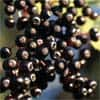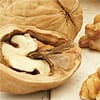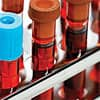
What's hot
What's hot
| News flashes are posted here frequently to keep you up-to-date with the latest advances in health and longevity. We have an unparalleled track record of breaking stories about life extension advances.
Orange juice the best beverage choice with fast food
Professor of medicine Paresh Dandona, MD and his associates at the University of Buffalo tested the effects of orange juice, a 300 calorie glucose drink or water in combination with a 900 calorie fast food breakfast on 30 normal-weight men and women. Blood samples obtained prior to the meal and 1, 3 and 5 hours later were analyzed for oxygen free radicals and factors involved in inflammation. Oxygen free radicals increased by an average of 47 percent among those who received orange juice, compared to 63 percent among those who received glucose and 62 percent in the group that received water. Inflammatory mediators, which included toll-like receptors, were lower in the orange juice group. The researchers attribute the benefits of orange juice observed in this study to the fruit’s abundance of the flavonoids naringenin and hesperidin. "Our data show, for the first time to our knowledge, that drinking orange juice with a meal high in fat and carbohydrates prevented the marked increases in reactive oxygen species and other inflammatory agents," announced first author Husam Ghanim, PhD. "This did not happen when participants drank water or a sugary drink with the meal. These issues of inflammation following a meal are important because the resultant high glucose and high triglycerides are known to be related to the development of cardiovascular events." "The choice of safe foods that are not proinflammatory may provide protection from the unending cycle of postprandial and cumulative inflammation," Dr Dandona added. "This choice may lower the risk of atherosclerosis and resistance to insulin." —D Dye
Blackcurrant compound could help asthmatics
In allergic asthma, long term inflammation occurs in response to allergen exposure in the lungs. Epidemiologic studies have associated increased fruit consumption with a reduction in allergy-induced asthma symptoms, yet a mechanism for fruit had not been determined. Roger D. Hurst and colleagues at The Plant and Food Research Institute of New Zealand tested a proanthocyanidin-enriched and an anthocyanin-rich New Zealand blackcurrant extract on cultured human alveolar (lung) epithelial cells. Both proanthocyanidins and anthocyanins have antioxidant properties and can reduce inflammation. The proanthocyanidin rich extract, but not the anthocyanin rich extract, dose-dependently suppressed interleukin-4- and interleukin-13-stimulated secretion of CCL26, which is a factor in the continuous recruitment of eosinophils (a type of white blood cell) that occurs in allergic asthma. Preincubation of the cells with the proanthocyanidin rich extract also suppressed interleukin-4 induced CCL26 secretion. The team determined that epigallocatechin and, to a lesser extent epicatechin metabolites found in the proanthocyanidin rich extract, were responsible for the reduction in inflammation that occurred. "To find natural compounds that potentially reduce lung inflammation and complement the body's own immune response is an exciting breakthrough," stated Dr Hurst. "Should we discover more about how this works we may eventually develop foods containing these compounds that could provide more natural alternatives to assist conventional drug treatments for asthma and even other allergic reactions." —D Dye
Arginine plus antioxidants improve physical performance in older men
"The loss of exercise capacity with age often results in a reduction in physical fitness and more rapid senescence," noted lead researcher Zhaoping Li of the University of California, Los Angeles David Geffen School of Medicine. "A dietary supplement that increases exercise capacity might help to preserve physical fitness by optimizing performance and improving general health and well being in older people." Dr Li’s team randomized 16 cyclists aged 50 to 73 to receive a placebo or a powdered supplement consisting of L-arginine, L-citrulline, vitamin C, vitamin E, folic acid taurine and alpha-lipoic acid, mixed with water. Blood samples were obtained at the beginning of the study, and after the first and third weeks, and physical performance was assessed by exercise testing on a stationary cycle. After one week, those who received arginine experienced a 16.7 percent increase in anaerobic threshold, which is the amount of work done before blood lactic acid begins to accumulate. Anaerobic capacity remained elevated at three weeks in the arginine group, while failing to increase in those who received the placebo. Arginine increases the production of nitric oxide, which helps relax vascular smooth muscle in the coronary and skeletal muscle arteries, thereby improving exercise capacity. Nitric oxide production declines with age, which may contribute to the age-related increase in cardiovascular disease. The addition of antioxidants to the formula prevented nitric oxide from being inactivated by oxygen free radicals. "We've demonstrated a 16.7% increase in anaerobic threshold,” Dr Li stated. “This indicates a potential role of arginine and antioxidant supplementation in improving exercise performance in elderly". —D Dye
Curcumin could delay the development of cirrhosis
"Chronic cholangiopathies [diseases of the liver’s bile ducts] such as primary sclerosing cholangitis (PSC) and primary biliary cirrhosis are characterised by progressive inflammation and subsequent development of biliary fibrosis and cirrhosis," the authors write in their introduction to the article. "Since the effectiveness of currently available medical therapies to slow the progression of cholangiopathies is limited, there is an urgent need for novel and effective medical treatment strategies." For their research, Michael Trauner of the Medical University Graz in Austria and colleagues used normal "wild-type" mice and mice bred to develop chronic bile duct disease. The animals were given a control diet or a diet enriched with curcumin for 4 or 8 weeks, following which blood and tissue samples were analyzed. The genetically modified animals that received curcumin for 4 and 8 weeks experienced reduced bile duct blockage and less liver cell damage and fibrosis compared to those given normal diets. The researchers found that curcumin interfered with several inflammatory signaling processes. The compound appears to inhibit the progression of fibrosis rather than reversing that which has already occurred. The study is the first of its kind to examine the effects of curcumin on bile duct inflammation and liver damage in a mouse model. The findings suggest the potential of curcumin to be evaluated as an effective alternative to ursodeoxycholic acid (the only currently available drug treatment) or as an agent that could help delay the need for liver transplantation. —D Dye
Walnuts may slow prostate cancer progression
Walnuts are a rich source of omega-3 fatty acids, gamma-tocopherol, polyphenols and antioxidants. Recent research has discovered that walnuts help protect against cardiovascular disease by lowering endothelin, a compound that increases inflammation within the blood vessels. Because endothelin is elevated in prostate cancer, Paul Davis, PhD, of the University of California, Davis and his colleagues sought to determine whether walnuts might help combat the disease. For their study, the researchers used 84 mice bred to develop prostate cancer by the age of 6 months. The animals were provided with a low fat diet, a high fat diet containing soy oil, or a high fat diet containing the equivalent of 14 shelled walnuts per day for 9, 18 and 24 weeks. At the end of the treatment periods, prostate gland weight, prostate and liver gene expression, and insulin-like growth factor (IGF-1, which can increase cancer growth) were measured. Mice that received the low fat diet had tumor weights at 18 weeks that were 60 percent lower than those fed the high fat diet, and those given walnuts had weights that were 46 percent less. Walnut-fed mice also had slower growing tumors as well as 30 percent lower IGF-1 levels than those on the high fat diet. Additionally, walnut consumption was associated with the beneficial expression of multiple genes that control tumor growth and metabolism. "Walnuts should be part of a prostate-healthy diet," Dr Davis recommended. "They should be part of a balanced diet that includes lots of fruits and vegetables." —D Dye
Low selenium levels associated with impaired blood glucose in men
Tasnime Akbaraly of the University of Montpellier and her associates evaluated data from 1,162 healthy participants in the Epidemiology of Vascular Ageing (EVA) study of men and women aged 59 to 71. Plasma selenium and fasting plasma glucose levels were measured upon enrollment, and glucose was re-evaluated at 2, 4 and 9 years. Over the 9 year follow-up period, there were 127 cases of dysglycemia, including 29 diagnoses of type 2 diabetes. Among men whose plasma selenium was among the highest one-third of participants at 1.19 to 1.97 micromoles per liter, there was a 52 percent lower risk of having abnormal blood glucose compared with men whose levels were lowest at 0.18 to 1 micromoles per liter. Controlling for other factors failed to significantly modify the association in men, however, a similar association was not observed in women. The current study adds evidence to previous studies that uncovered a lower level of selenium in diabetic patients, and contradicts a National Health and Nutrition Examination Survey (NHANES) finding of an association between higher serum selenium levels and an increased risk of diabetes and higher fasting glucose. "Our results showed that for French elderly males, having plasma selenium concentrations in the top tertile of the population distribution was significantly associated with a lower risk of developing dysglycemia over the following nine years," Dr Akbaraly commented. "The reason we observed a protective effect of selenium in men but not in women is not completely clear, but might be attributed to women being healthier at baseline, having better antioxidant status in general and possible differences in how men and women process selenium." —D Dye
Meta-analysis finds higher vitamin B6 levels associated with lower colorectal cancer risk
“Although vitamin B6 is found in a wide variety of foods, many older people do not obtain an adequate intake of this nutrient,” write Susanna C. Larsson, PhD and coauthors. “In the United States, the prevalence of inadequate vitamin B6 intake for adults older than 50 years is about 20% for men and 40% for women.” For their review, Dr Larsson and her colleagues at the Karolinska Institute in Stockholm selected 9 studies that evaluated the association between dietary vitamin B6 intake and colorectal cancer risk and 4 studies that evaluated blood PLP levels’ association. Pooled analysis of studies involving vitamin B6 intake found a 10 percent lower risk among those with high compared to low intake. Removing one heterogenous study from the analysis resulted in an association of higher intake with a 20 percent decrease in risk. Analysis of blood pyridoxal 5’-phosphate levels uncovered a 48 percent risk reduction associated with high versus low levels. Each 100 picomole per milliliter increase in blood PLP was associated with a 49 percent reduction in colorectal cancer risk. The stronger association between colorectal cancer risk reduction and blood PLP levels compared to vitamin B6 intake could be attributable to errors in assessment of dietary vitamin B6, since research has shown strong correlations between PLP levels and amounts consumed. “The findings from these observational studies need to be confirmed in large randomized clinical trials of vitamin B6 supplementation,” Dr Larsson and her associates recommend. —D Dye
ED predicts death within 5 year period
The research included 1,519 participants in a substudy of the ONTARGET and TRANSCEND trials of cardiovascular patients. Responses to questionnaires administered upon enrollment and after two years or at the conclusion of the follow-up period were used to categorize ED as mild, mild to moderate, moderate or severe. Fifty-five percent of the participants reported ED at the beginning of the trials. Eleven percent of these men died, compared to 5.6 percent of men with no or mild ED. Sixteen percent experienced cardiovascular death, heart attack, stroke, or heart failure hospitalization, compared to 10.3 who had no or mild dysfunction. “It is likely that the presence of ED identified individuals whose cardiovascular disease might be far more advanced than when evaluated with other clinical parameters alone," noted lead author Michael Böhm, MD, who is the chairman of internal medicine in the Department of Cardiology and Intensive Care at the University of Saarland, Germany. "Men with ED going to a general practitioner or a urologist need to be referred for a cardiology workup to determine existing cardiovascular disease and proper treatment. ED is an early predictor of cardiovascular disease." Dr Böhm observed that some men obtain a prescription for erectile dysfunction without being evaluated for heart disease. "The medication works and the patient doesn't show up anymore," he remarked. "These men are being treated for the ED, but not the underlying cardiovascular disease. A whole segment of men is being placed at risk." —D Dye
Increased vitamin D levels linked with lower hemoglobin A1C
The team analyzed data from 9,773 participants aged 18 and older in the National Health and Nutrition Examination Survey (NHANES) 2003-2006. Among those aged 35 to 74, an inverse association between serum 25-hydroxyvitamin D and hemoglobin A1C was observed. The effect was not seen in those who reported a history of diabetes, or who were 75 years of age or older, a fact that the authors suggest could be due to smaller sample sizes and/or confounding by treatment status. Higher parathyroid hormone levels and dietary supplement use were also correlated with lower A1c levels in the 35 to 74 year age group. Among possible mechanisms proposed for vitamin D were improvements in insulin secretion and sensitivity. “This analysis supports an inverse association between vitamin D status and A1c levels in the U.S. adult population 35-74 years of age, which is nearly two-thirds of all U.S. adults, and subjects who do not report a history of diabetes” the authors write. “This suggests a mechanistic link between serum vitamin D concentrations, glucose homeostasis, and the evolution of diabetes in a large segment of U.S. adults at the population level.” “Whether vitamin D supplementation can delay the onset of diabetes remains to be established,” they conclude. “Therefore, future studies to clarify the efficacy of vitamin D supplementation in preventing diabetes and pre-diabetes are warranted, especially in populations at high risk. —D Dye
Immune system’s killer cells need vitamin D
Carsten Geisler of the University of Copenhagen’s Department of International Health, Immunology and Microbiology and colleagues discovered that naïve human T cells had low expression of a phospholipase C isozyme, which was associated with reduced T cell antigen responsiveness. Induction of phospholipase C-gamma1 was found to be dependent on vitamin D and the expression of the vitamin D receptor. "When a T cell is exposed to a foreign pathogen, it extends a signaling device or 'antenna' known as a vitamin D receptor, with which it searches for vitamin D,” explained Dr Geisler. “This means that the T cell must have vitamin D or activation of the cell will cease. If the T cells cannot find enough vitamin D in the blood, they won't even begin to mobilize. " “Scientists have known for a long time that vitamin D is important for calcium absorption and the vitamin has also been implicated in diseases such as cancer and multiple sclerosis, but what we didn't realize is how crucial vitamin D is for actually activating the immune system – which we know now," Dr Geisler stated. He predicted that the findings "could help us to combat infectious diseases and global epidemics. They will be of particular use when developing new vaccines, which work precisely on the basis of both training our immune systems to react and suppressing the body's natural defenses in situations where this is important – as is the case with organ transplants and autoimmune disease." —D Dye
Vitamin D for diabetes and depression
“Vitamin D deficiency continues to be a problem despite the nutrient’s widely reported health benefits,” noted Sue Penckofer, PhD, RN, who is a professor at the MNSON. “Chicago winters compound this issue when more people spend time away from sunlight, which is a natural source of vitamin D.” Increased insulin resistance has been associated with depression, which, along with impaired blood sugar control, is more common in women than men. Higher vitamin D levels have been associated with a reduced risk of depression, diabetes and other ailments. The University plans to administer 50,000 international units of vitamin D per week for 6 months to 80 stable type 2 diabetic women aged 18 to 70 with signs of depression. Participants will be evaluated at three time points for serum vitamin D levels and other factors. “There is evidence to suggest that vitamin D supplementation may decrease insulin resistance,” Dr Penckofer commented. “If we can stabilize insulin levels, we may be able to simply and cost effectively improve blood sugar control and reduce symptoms of depression for these women.” "Vitamin D has widespread benefits for our health and certain chronic diseases in particular," she added. "Our research may shed greater light on the role this nutrient plays in managing two conditions that impact millions of Americans. If proven to be successful, vitamin D may an important addition to care for diabetes and depression." —D Dye
Increased garlic consumption linked to lower levels of carcinogen
Penn State University researchers gave volunteers a nontoxic form of sodium nitrate along with capsules containing 1, 3 or 5 grams fresh garlic, 3 grams aged garlic extract, or 500 milligrams vitamin C for 7 days. Urine samples collected during the treatment period were analyzed by Earl Harrison and colleagues for the garlic metabolite N-acetyl-S-allylcysteine and N-nitrosoproline, a marker of nitrosation. Higher levels of N-acetyl-S-allylcysteine correlated with lower amounts of N-nitrosoproline. Three to 5 grams of fresh garlic inhibited nitrosation similarly to aged garlic and vitamin C. “What we were after was developing a method where we could measure in urine two different compounds, one related to the risk for cancer, and the other which indicates the extent of consumption of garlic,” explained Dr Harrison, who is a professor of human nutrition at Ohio State University. “Our results showed that those were inversely related to one another – meaning that the more we had the marker for garlic consumption, the less there was of the marker for the risk of cancer.” “The precise mechanism by which garlic and other compounds affect nitrosation is under extensive investigation, but is not clear at this time,” he added. “What this research does suggest, however, is that garlic may play some role in inhibiting formation of these nitrogen-based toxic substances.” —D Dye
Vitamin D deficiency common among kidney disease patients
The research involved 908 men and women for whom serum 25-hydroxyvitamin D levels were measured upon enrollment in the Accelerated Mortality on Renal Replacement (ArMORR) cohort of U.S. dialysis patients. Ishir Bhan, MD, MPH and his colleagues at Massachusetts General Hospital found deficient vitamin D levels of less than 30 nanograms per milliliter in 79 percent of the subjects. Fifty-seven percent had levels less than 20 nanograms per milliliter and 20 percent had levels lower than 10 nanograms per milliliter. African Americans, women, subjects with low serum albumin levels, and those who initiated hemodialysis during winter were likeliest to be deficient in vitamin D. Having reduced albumin levels and beginning chronic hemodialysis during winter increased the likelihood of vitamin D deficiency from 66 percent to 92 percent in white males, from 82 percent to 94 percent in white females, and from 85 and 90 percent to 100 percent in black males and females. According to the authors, the association of low blood albumin levels with vitamin D deficiency may be due to poor nutrition, chronic inflammation, or an increased loss of vitamin D binding proteins along with other proteins in the urine of kidney disease patients. The increased incidence of vitamin D deficiency during winter is likely to be due to reduced ultraviolet exposure, which results in less vitamin D being formed in the skin. "This research identifies risk factors for nutritional vitamin D deficiency in the dialysis population and may provide clues to its biology in this population," Dr Bhan concluded. —D Dye
|

 The April, 2010 issue of the
The April, 2010 issue of the  Epigallocatechin found in blackcurrants could reduce the inflammation that is involved in allergic
Epigallocatechin found in blackcurrants could reduce the inflammation that is involved in allergic  An article published online on March 23, 2010 in the
An article published online on March 23, 2010 in the  A report published on March 24, 2010 in the journal
A report published on March 24, 2010 in the journal  The 239th National Meeting of the American Chemical Society (ACS), held in San Francisco, was the site of a presentation on March 22, 2010 which revealed that consuming walnuts may help reduce the growth of
The 239th National Meeting of the American Chemical Society (ACS), held in San Francisco, was the site of a presentation on March 22, 2010 which revealed that consuming walnuts may help reduce the growth of  A report published on March 17, 2010 in the journal
A report published on March 17, 2010 in the journal  The results of a meta-analysis published in the March 17, 2010 issue of the
The results of a meta-analysis published in the March 17, 2010 issue of the  An analysis of men with cardiovascular disease and erectile dysfunction (ED), published in the March 16, 2010 issue of
An analysis of men with cardiovascular disease and erectile dysfunction (ED), published in the March 16, 2010 issue of  In an article published online on March 9, 2010 in the journal
In an article published online on March 9, 2010 in the journal  An article published online on March 7, 2010 in
An article published online on March 7, 2010 in  A clinical trial is being planned at Loyola University Chicago Marcella Niehoff School of Nursing (MNSON) to test the effect of vitamin D supplementation on insulin resistance and mood in diabetic women.
A clinical trial is being planned at Loyola University Chicago Marcella Niehoff School of Nursing (MNSON) to test the effect of vitamin D supplementation on insulin resistance and mood in diabetic women. A small pilot study summarized in the November 15, 2009 issue of the journal
A small pilot study summarized in the November 15, 2009 issue of the journal  An article published online ahead of print in the
An article published online ahead of print in the